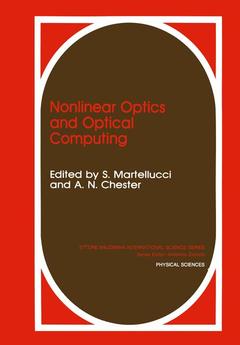Nonlinear Optics and Optical Computing, Softcover reprint of the original 1st ed. 1990 Polymer Science and Technology Series, Vol. 19
Langue : Anglais

The conference "Nonlinear Optics and Optical Computing" was held May 11-19, 1988 in Erice, Sicily. This was the 13th conference organized by the International School of Quantum Electronics, under the auspices of the "Ettore Majorana" Center for Scientific Culture. This volume contains both the invited and contributed papers presented at the conference, providing tutorial background, the latest research results, and future directions for the devices, structures and architectures of optical computing. The invention of the transistor and the integrated circuit were followed by an explosion of application as ever faster and more complex microelectronics chips became available. The information revolution occa sioned by digital computers and optical communications is now reaching the limits of silicon semiconductor technology, but the demand for faster com putation is still accelerating. The fundamental limitations of information processing today derive from the performance and cost of three technical factors: speed, density, and software. Optical computation offers the potential for improvements in all three of these critical areas: Speed is provided by the transmission of impulses at optical veloc ities, without the delays caused by parasitic capacitance in the case of conventional electrical interconnects. Speed can also be achieved through the massive parallelism characteristic of many optical computing architec tures; Density can be provided in optical computers in two ways: by high spatial resolution, on the order of wavelengths of light, and by computa tion or interconnection in three dimensions.
Optical Nonlinearities and Bistability.- Theory of optical bistability and optical memory.- Dynamic operation of nonlinear waveguide devices for fast optical switching.- Optical bistability in coupled-cavity semiconductor lasers.- Semiconductor bistable etalons for digital optical computing.- Three photon ionization of Na atoms and related plasma phenomena.- Quantum Wells and Fast Nonlinearities.- Ultrafast dynamical nonlinearities in III-V semiconductors.- Nonlinear optical materials and devices.- Excitonic optical nonlinearities, four wave mixing and optical bistability in multiple quantum well structures.- Nonlinear optics of a single slightly-relativistic cyclotron electron.- Principles of optical computing.- Optical associative memory.- Optical computing using phase conjugation.- Nonlinear photorefractive effects and their application in dynamic optical interconnects and image processing.- Materials and Devices.- Ultrafast all-optical switching in optical fibers.- Nonlinear coupling to ZnS, ZnO and SDG planar waveguides: theory and experimental study.- Nonlinearity at an interface.- Suggestion for Further Reading.- Polarization instability in crystals with nonlinear anisotropy and nonlinear gyrotropy.- Selected references on optical computing using phase conjugation.
Date de parution : 04-2013
Ouvrage de 285 p.
17x24.4 cm
Mots-clés :
atoms; density; electron; nonlinear optics; optics; photon; plasma; semiconductor; stability; wave
© 2024 LAVOISIER S.A.S.



